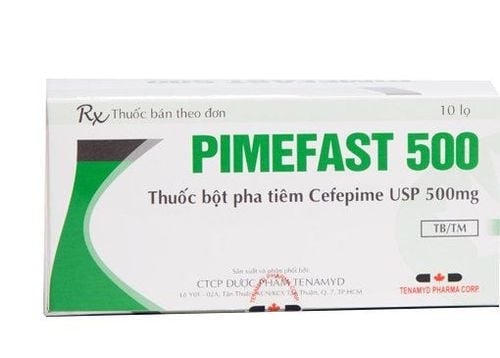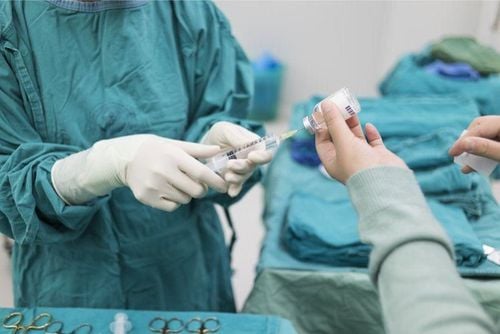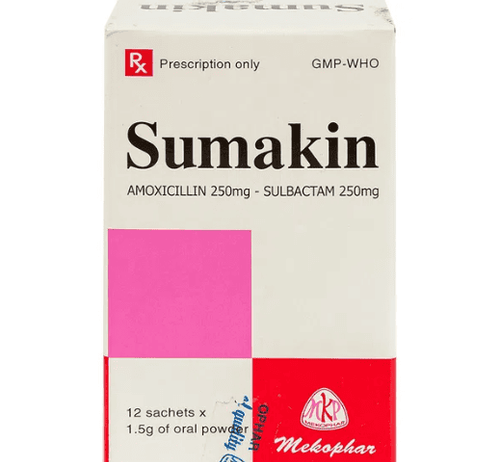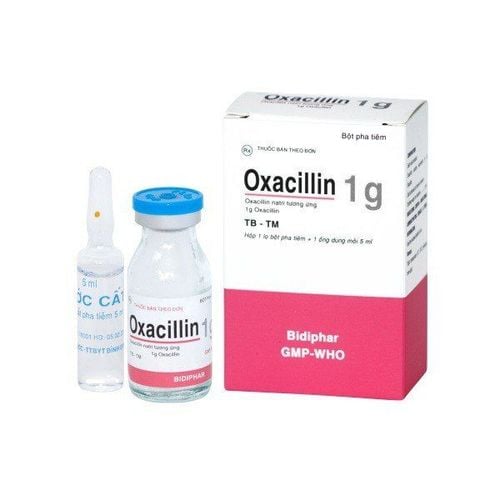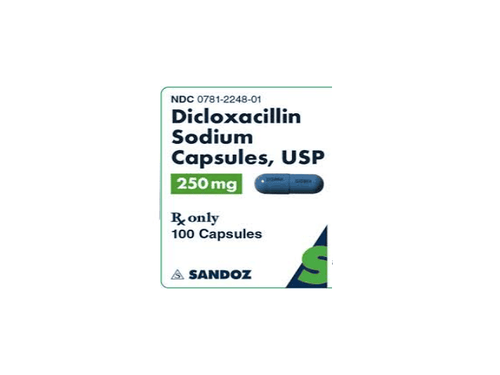This is an automatically translated article.
Ceficad 1000 is commonly used to treat bacterial infections caused by bacteria sensitive to Cefepim, such as skin infections, bacteremia, severe pneumonia,... To ensure safe use of Ceficad 1000 To be safe and effective soon, patients need to follow the doctor's instructions throughout the treatment period.
1. What is Ceficad 1000?
Ceficad 1000 is a prescription drug (ETC) for the treatment of infections caused by susceptible bacteria, such as urinary tract infections, meningitis, fever, neutropenia,... manufactured by Cadila Pharm., Ltd - India, in the form of powder for injection, each box includes one vial.
Each vial of Ceficad 1000 powder for injection contains the following active ingredients:
Main active ingredient: Cefepim (in the form of Cefepim Hydrochloride) 1000mg. Other excipients: L-Arginin (Premixed sterile powder form L-Arginin and Cefepim Hydrochloride)
2. Uses of the active ingredient Cefepim in Ceficad 1000
Active ingredient Cefepim is known as an antibiotic of the Beta Lactam family, belonging to the 4th generation Cephalosporin group. Cefepim has antibacterial activity on 90% of susceptible species, including: Shigella, Proteus vulgaris, Proteus mirabilis , Morganella morganii, Escherichia coli, Salmonella, Citrobacter diversus, Klebsiella oxytoca, Serratia, Providencia, Citrobacter freundii*, Neisseria, Branhamella catarrhalis, streptocoques, Streptococcus pneumoniae, Haemophilus influenzae,...
Based on pharmacokinetic properties and activity Cefepim's antibacterial agent, this active ingredient is often indicated for use in the treatment of bacterial infections for both children and adults, specifically:
Infections in adults: Community-acquired lower respiratory tract infections copper, bacteremia, sepsis, urinary tract infection with/without complications, severe pneumonia, fever due to neutropenia, biliary tract infection. Bacterial infections in children: Urinary tract infections with/without complications, pneumonia, sepsis, skin/skin structure infections, meningitis or febrile neutropenia.
3. Indications and contraindications for the use of Ceficad 1000
3.1. Indications for the use of Ceficad 1000 Currently, doctors often prescribe Ceficad 1000 to effectively treat infections caused by susceptible bacteria below:
Treatment of moderate to severe pneumonia. Treatment of fever due to neutropenia (using Ceficad 1000 monotherapy in the period of high fever). Treatment of urinary tract infections with/without complications, including pyelonephritis or nephritis. Treatment of complicated intra-abdominal infections (using combination of Ceficad 1000 with metronidazole). Treatment of uncomplicated moderate to severe skin or skin structure infections. In order to maintain the effectiveness of Ceficad 1000 and its combination antibiotics in the treatment of infections and to reduce the development of resistant strains of bacteria, patients should only use Ceficad 1000 as therapy for the treatment of infections. Treatment and prophylaxis of infections when the cause of the infection is firmly established.
3.2. Contraindication to the use of Ceficad 1000 Ceficad 1000 should not be used for the following subjects:
Patients with hypersensitivity or allergic reactions to the active ingredient Cefepim, antibiotics of the Penicillin group, Cephalosporin or other Beta lactams . The patient is sensitive to the L-Arginine component of the drug Ceficad 1000. The patient has severe renal failure. Children under 2 months old. Pregnant women. Women who are breastfeeding.
4. Dosage and how to use Ceficad 1000 effectively
4.1. Dosage of the drug Ceficad 1000 Ceficad 1000 is usually used at the dose prescribed by the doctor, specifically:
Dosage of Ceficad 1000 for adults:
Below is the dose of Ceficad 1000 for adults with clearance Creatinine clearance > 60ml/min:
Treatment of moderate-severe pneumonia: Intravenous (IV) dose of 1-2g/ 12 hours for 10 consecutive days. Treatment of neutropenic fever: Intravenous dose of 2g / 12 hours continuously for 7 days. Treatment of urinary tract infections with/without complications (mild - moderate): Intravenous dose 0.5 - 1g / 12 hours, used within 7-10 days. Treatment of urinary tract infections with/without complications (moderate-severe): Intravenous dose of 2g/ 12 hours continuously for 10 days. Treatment of uncomplicated moderate to severe skin/skin structure infections: Intravenous dose of 2g/ 12 hours continuously for 10 days. Treatment of complicated intra-abdominal infections: Intravenous dose of 2g/ 12 hours continuously for 7-10 days. Dosage of Ceficad 1000 for children:
Below is the dose of Ceficad 1000 for children from 2 months to 12 years of age with normal kidney function:
Treatment of urinary tract infections, pneumonia, skin infections / skin structure in pediatric patients > 2 months of age and body weight < 40 kg: 50 mg/kg every 12 hours for 10 days. For severe infections, the interval between doses may be shortened to about 8 hours. Treatment of neutropenic fever: 50 mg/kg body weight/ 12 hours from 7-10 days. For children > 40 kg, the same dose of Ceficad can be used as adults. For children > 12 years of age but weighing < 40 kg, the same dose should be used as for pediatric patients < 40 kg. Dosage of Ceficad 1000 for patients with hepatic and renal impairment:
As recommended, the dose of Ceficad for patients with impaired liver function does not need to be adjusted. However, patients with renal impairment and clearance < 60 ml/min will need to adjust the dose of Ceficad 1000 based on the degree of renal elimination, specifically:
Clearance from 30 to 60 ml/min: Use dose 2g/ 12 hours. Clearance from 11 to 29ml/min: Dose of 2g/24 hours. Clearance less than 11ml/min: Administer 1g/24 hours. 4.2. Instructions on how to use Ceficad 1000 The drug Ceficad 1000 is a powder for injection, so the drug is usually used by deep intramuscular injection, intravenous injection or intravenous infusion. The specific route of using Ceficad 1000 will be based on the doctor's assessment of the patient's infection status.
Here is how to make a solution of Ceficad 1000 for intramuscular injection, injection or intravenous infusion:
Solution for intramuscular injection: Mix 1g of Cefepim with 3ml of sterile water for injection or 1% or 5% Lidocaine hydrochloride solution to collect drug solution with a concentration of approximately 240mg/ml. Intravenous solution: Mix 1g of Cefepim with about 10ml of sterile water for injection or other compatible diluent for injection such as Glucose 5% or 10% and Sodium chloride 0.9% to make a solution for slow intravenous injection. has a concentration of approximately 90mg/ml. Intravenous solution: Mix 1g of Cefepim with 50-100ml of solvent for injection such as 0.9% sodium chloride and 5% or 10% glucose to make a drug solution with a concentration of 20-10mg/ml. The drug is given by intermittent intravenous infusion over 30 minutes. 4.3. Treatment of Ceficad 1000 Overdose When injecting / infusion of Ceficad 1000 overdose, patients may experience symptoms of neurological disease such as dizziness, confusion, hallucinations or coma. In addition, a number of other adverse reactions to Ceficad 1000 overdose may also occur, including myoclonus, neuromuscular excitability, or seizures.
For patients who overdose on Ceficad 1000 will need to closely monitor the body's reactions and apply supportive measures as soon as possible. In the case of patients with kidney failure, the doctor may recommend hemodialysis to remove Cefepim from the body instead of peritoneal dialysis.
5. The side effects of the drug Ceficad 1000
In general, the active ingredient Cefepim is well absorbed when loaded into the body, however, in certain cases, the drug can cause patients to experience some unintended side effects. According to clinical studies, the most common side effects of Ceficad 1000 are digestive problems and symptoms of drug sensitivity.
Side effects have a rate of 0.1 - 1% when using Ceficad 1000, including:
Skin rash, urticaria or itching. Oral candidiasis, vomiting, diarrhea, pseudomembranous colitis or colitis. Headache, vaginitis or fever. Side effects have a rate of occurrence from 0.05 to 0.1% when taking Ceficad 1000, including:
Constipation, abdominal pain, shortness of breath or vasodilation. Unusual sensations, dizziness, loss of taste or chills. Atypical candidiasis or genital pruritus. Side effects with occurrence rate < 0.05% when using Ceficad 1000, include:
Local reactions at the injection site, inflammation or phlebitis. Pain at the injection site. Increased Bilirubin. Eosinophilia increased. Decreased blood calcium. Prolong blood clotting time. Coombs test false positive. Transient elevation of blood urea. Increased plasma creatinine. Leukopenia . Transient decrease in neutrophils. Decreased platelets. When any of the side effects mentioned above appear during treatment with Ceficad 1000, the patient should notify the doctor immediately so that measures can be taken as soon as possible.
6. Note before and during the use of Ceficad 1000
Here are some recommendations that patients should refer to before and during treatment with Ceficad 1000:
It is necessary to check whether the patient's body has an allergic reaction to Cefepim, Penicillin or Cephalosporin or not before starting treatment with Ceficad. There is a risk of cross-sensitivity to penicillin with beta-lactams. In patients with renal impairment with a clearance of less than 60 ml/min, the dose of Ceficad 1000 should be adjusted accordingly to prevent the risk of renal impairment. The use of Ceficad can cause mild to severe pseudomembranous enterocolitis. Therefore, caution should be exercised when diagnosing cases of patients with diarrhea following antibiotic use. Elderly patients (>65 years) with renal impairment require dose adjustment of Ceficad 1000 to avoid the risk of life-threatening reactions such as confusion, encephalopathy, coma, hallucinations, seizures, ...
7. Interactions with other drugs
According to research, Ceficad 1000 may have an adverse interaction when co-administered with the following drugs:
Aminoglycoside drugs used in high doses concurrently with Ceficad 1000 may increase nephrotoxicity. The combination of Ceficad 1000 and a potent diuretic (Frosemide) can cause nephrotoxicity. Causes physical and chemical incompatibilities if Cefepim is mixed with Gentamycin sulphate, vancomycin hydrochloride, Aminophylline and Furosemide. Causes a false-positive urine glucose test when Cefepim is administered concomitantly with Clinitest tablets. The article has provided information about the uses, doses and precautions when using Ceficad 1000. To ensure your health and maximize the effectiveness of your treatment, you need to use Ceficad 1000 exactly as directed. doctor's instructions.
Follow Vinmec International General Hospital website to get more health, nutrition and beauty information to protect the health of yourself and your loved ones in your family.
Please dial HOTLINE for more information or register for an appointment HERE. Download MyVinmec app to make appointments faster and to manage your bookings easily.





